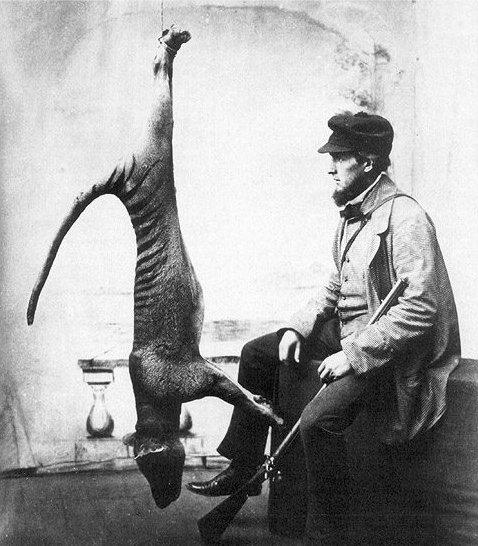
Public domain image of Mr Weaver and his bagged thylacine, 1869
[This book review was written when the book was first published]
I’ve been a big fan of Errol Fuller’s thoughtful prose for about 13 years. When I was finishing my undergraduate degree I had my imagination fired by reading some papers on ancient DNA, which sent me into a flurry of research, trying to find out everything I could about the rare and the recently extinct. In the early 2000s this meant reading about Higuchi’s work on the Quagga (Equus quagga), Pääbo’s work on the Thylacine (Thylacinus cynocephalus), and Cooper’s work on New Zealand moa (Dinornithiformes). This was a pivotal point in my life. So much so that I eventually directly emailed Alan Cooper during my final year, to ask about postgraduate opportunities in his Oxford lab. I was lucky enough to be taken on for a BBSRC D.Phil position there and that was the beginning of my professional introduction to the world of ancient biomolecules. Anyway, what blew my mind back then was the sheer scale of recent extinction events. Despite having been interested in science and biology for my whole life, I had never heard of the great auk (Alca impennis), the solitaire (Pezophaps solitarius), Steller’s sea cow (Hydrodamalis gigas), Delalande’s coua, (Coua delalandei) the Huia (Heterolochas acutirostris), and all those other amazing animals that we just missed out on seeing. I researched these species for a course essay but found instead that I was so consumed by the need to find out about them that I spent most of the year researching every obscure and little-known extinct species I could find, on the internet and in the University’s library holdings. I also spent a lot of time at the Royal Museum of Scotland at their excellent exhibit on extinction. One day while in the museum shop I spotted a copy of Fuller’s “The Great Auk” and despite my meagre student budget, and its hefty price, I had to buy it. If there has ever been a more thorough account of the life, habits, and relics of a single extinct species then I don’t know of it. Pure scholarship and a delight to read. Every facet of this extinct bird was explored and new information was there on each page. After that I knew I had to read more and Fuller’s “Extinct Birds” was the one thing I asked for for Christmas that year. The two books have been read and re-read many, many times and are just a joy to leaf through. When I heard (on Twitter) that there was a new book coming soon on extinction and the photographic record I knew I had to get that as well. And I wasn’t disappointed. “Lost Animals” is a bittersweet delight. I’ve read some of the criticisms of the book online, saying that it is dumbed down, but I think that misses the point. The text is entirely secondary to the power of the images contained within. The Thylacine was persecuted to extinction by bounty and hunter, yet now with the passage of time the few feet of film and handful of photographs speak powerfully of the human weakness of only caring enough when it is too late. The focus of the writing is properly on the people who came to capture these fleeting glimpses of living animals. Often they knew they were glimpsing something that would never happen again. Sometimes the importance of the pictures they had stuffed in a shoebox in the attic only became clear decades later. I loved this book and read it in a single sitting. I don’t think I will revisit the text as often as I do with “The Great Auk” or “Extinct Birds” but the pictures- from the delicate, silvered plates to the exuberant kodachrome prints will be a part of my mind palace for evermore.
Written by Ross Barnett (@DeepFriedDNA)
Further Reading:
Lost Animals: Extinction and the photographic record, Errol Fuller [Buy the book]
Advertisements Share this:




